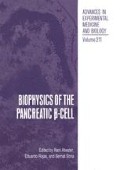Abstract
Previous studies have shown that glucose-induced insulin release is inhibited by substitution of Cl- with non-permeant mono-valent anions such as isethionate,9,10–13 para-aminohippurate,11 or methyl sulphate.13 The precise mechanism behind this apparent Cl- dependence is unclear but the demonstration of a strong correlation between radioactive Cl- efflux from prelabelled islets and insulin release may indicate that Cl- transport in the β-cell is important for the regulation of insulin release.10,11 The present paper concerns the basic question, whether glucose-induced insulin release is strictly Cl--dependent or whether it rather shows anion selectivity. To this end, a study has been undertaken to measure the effects of a number of anions on insulin release and to compare the secretory effects of anions with their capacity to interfere with islet 45Ca2+ uptake.
Access this chapter
Tax calculation will be finalised at checkout
Purchases are for personal use only
Preview
Unable to display preview. Download preview PDF.
References
M. Gomolla, G. Gottschalk, and H. Ch. Luttgau, Perchlorate-induced alterations in electrical and mechanical parameters of frog skeletal muscle fibers, J. Physiol. 343:197 (1983).
H. J. Hahn, B. Hellman, A. Lernmark, J. Sehlin, and I.-B. Taljedal, The pancreatic β-cell recognition of insulin secretagogues. Influence of neuraminidase treatment on the release of insulin and the islet content of insulin, sialic acid, and cyclic adenosine 3′:5′-monophosphate, J. Biol. Chem. 249:5275 (1974).
W. G. Hanstein, Chaotropic ions and their interactions with proteins, J. Solid-Phase Biochem. 4:189 (1979).
W. G. Hanstein, K. A. Davis, and Y. Hatefi, Water structure and the chaotropic properties of haloacetates, Arch. Biochem. Biophys. 147:534 (1971).
C. Hellerstrom, A method for the microdissection of pancreatic islets of mammals, Acta Endocrinol. (Kbh.) 45:122 (1964).
B. Hellman, Studies in obese-hyperglycemic mice, Ann. N. Y. Acad. Sci. 131:541 (1965).
B. Hellman, J. Sehlin, and I.-B. Taljedal, Effects of glucose on 45Ca2+ uptake by pancreatic islets as studied with the lanthanum method, J. Physiol. 254:639 (1976).
H. C. Luttgau, G. Gottschalk, L. Kovacs, and M. Fuxreiter, How Perchlorate improves excitation-contraction coupling in skeletal muscle fibers, Biophys. J. 43:247 (1983).
C. S. Pace and J. S. Smith, The role of chemiosmotic lysis in the exocytotic release of insulin, Endocrinol. 113:964 (1983).
J. Sehlin, Interrelationship between chloride fluxes in pancreatic islets and insulin release, Am. J. Physiol. 235:E501 (1978).
J. Sehlin, Univalent ions in islet cell function, Horm. Metab. Res. Suppl. Ser. 10:73 (1980).
G. Somers, A. Sener, G. Devis, and W. J. Malaisse, The stimulus-secretion coupling of glucose-induced insulin release. XLV. The anion-osmotic hypothesis for exocytosis. Pflugers Arch. 388:249 (1980).
T. Tamagawa and J. C. Henquin, Chloride modulation of insulin release, 86Rb+ efflux and 45Ca2+ fluxes in rat islets stimulated by various secretagogues. Diabetes 32:416 (1983).
C. B. Wollheim and G. W. G. Sharp, Regulation of insulin release by calcium, Physiol Rev. 61:914 (1981).
E. M. Wright and J. M. Diamond, Anion selectivity in biological systems, Physiol. Rev. 57:109 (1977).
Author information
Authors and Affiliations
Editor information
Editors and Affiliations
Rights and permissions
Copyright information
© 1986 Plenum Press, New York
About this chapter
Cite this chapter
Sehlin, J. (1986). The Role of Anions in the Regulation of Insulin Secretion. In: Atwater, I., Rojas, E., Soria, B. (eds) Biophysics of the Pancreatic β-Cell. Advances in Experimental Medicine and Biology, vol 211. Springer, Boston, MA. https://doi.org/10.1007/978-1-4684-5314-0_21
Download citation
DOI: https://doi.org/10.1007/978-1-4684-5314-0_21
Publisher Name: Springer, Boston, MA
Print ISBN: 978-1-4684-5316-4
Online ISBN: 978-1-4684-5314-0
eBook Packages: Springer Book Archive

